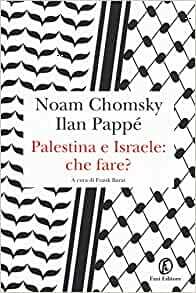Take a photo of a barcode or cover
The best read you can pick up if you want to understand more of the long-standing fight in Palestine against occupation. The book highlighted the common patterns we see with “israel”i assaults and the general strategy they follow to receive support internationally.
It’s really short too — as a 205-page read. The first half is structured as a conversation, moderated by Frank Barat; then the rest is a strong narration of the significant events that unfolded in Palestine by Noam Chomsky and Ilan Pappé. It debunks hundreds of zionist arguments and explains why they are designed to mislead people.
Highly recommend!
It’s really short too — as a 205-page read. The first half is structured as a conversation, moderated by Frank Barat; then the rest is a strong narration of the significant events that unfolded in Palestine by Noam Chomsky and Ilan Pappé. It debunks hundreds of zionist arguments and explains why they are designed to mislead people.
Highly recommend!
The interview-style narrative was personally really hard for me to follow but I still learned a lot.
dark
reflective
sad
medium-paced
It's good - it is an actual material analysis which is nice. Most of the history is fairly modern, though there is some pre-70s context provided. I like the conversational setup of most of this work, and I do appreciate its return to certain major themes. "Israel has chosen expansion over security" has been sticking with me, as well as the sarcastic treatment of Israel's hypocrisy re: the election of Hamas. It's a good read to help shore up your own resolve on this issue.
challenging
informative
slow-paced
I have a lot of thoughts on this book (and how it was written 10 years ago and nothing has changed) and Agamben’s ideas of the state of conception, the camp, and bare life. A few quotes from the book:
“Ethnic cleansing’s most preferred method is expulsion and dislocation, but in the case of Israel this was not always possible…They found that if you cannot expel someone, the second-best option is not to allow him or her to move. Enclaving people in villages and towns and disallowing any spatial expansion of human habitats became the hallmark of Israel’s ethnic cleansing after 1948, and it is still used today very effectively. When asked to explain why one new Palestinian village or town was not allowed to be built between the River Jordan and the Mediterranean, the official Israel line is that Palestinians do not need the same space as Jews do not need the same space as Jews do and are quite happy to be stuck in their homes without free access to green spaces around them.
And
But not only a historical view is needed for a better understanding of the massacre in Gaza; a dialectical approach that identifies the connection between Israel’s immunity and the horrific developments elsewhere is required as well. The dehumanization in Iraq and Syria is wide spread and terrifying, as it is in Gaza/ But there is one crucial difference between these cases and the Israeli brutality: the former are condemned as barbarous and inhuman worldwide, while those committed by Israel are still publicly licensed and approved by the president of the United States, the leaders of the European Union, and Israel’s other friends in the world.
[all these acts of violence] are acts that can only be perpetrated if the victim is dehumanized. The only chance for a successful struggle against Zionism in Palestine is the one based on a human and civil rights agenda that does not differentiate between one violation and the other yet identifies clearly the victim and the victimizers.
And perhaps the most distinct:
When those three goals are translated into actual policies they can only produce an inhuman and ruthless reality on the ground. There can be no benign or enlightened version for a policy mean to keep people in citizenless status or a long period of time. Only one human intervention operates in such a way which robs temporarily, or for longer periods of times, the basic human and civil rights of citizens: the modern-day prison.
Agamben, ironically situating his studies in the content of the holocaust and the concentration camp, wrote that, “when our age tried to give the unlocalizable a permanent and visible localization, the result was the concentration camp.”
And
“The camp is the space that is opened when the state of exception begins to become the rule. In
the camp, the state of exception, which was essentially a temporary suspension of the rule of law
on the basis of a factual state of danger, is now given a permanent spatial arrangement, which as
such nevertheless remains outside the normal order.” (HS 168-69)
“Ethnic cleansing’s most preferred method is expulsion and dislocation, but in the case of Israel this was not always possible…They found that if you cannot expel someone, the second-best option is not to allow him or her to move. Enclaving people in villages and towns and disallowing any spatial expansion of human habitats became the hallmark of Israel’s ethnic cleansing after 1948, and it is still used today very effectively. When asked to explain why one new Palestinian village or town was not allowed to be built between the River Jordan and the Mediterranean, the official Israel line is that Palestinians do not need the same space as Jews do not need the same space as Jews do and are quite happy to be stuck in their homes without free access to green spaces around them.
And
But not only a historical view is needed for a better understanding of the massacre in Gaza; a dialectical approach that identifies the connection between Israel’s immunity and the horrific developments elsewhere is required as well. The dehumanization in Iraq and Syria is wide spread and terrifying, as it is in Gaza/ But there is one crucial difference between these cases and the Israeli brutality: the former are condemned as barbarous and inhuman worldwide, while those committed by Israel are still publicly licensed and approved by the president of the United States, the leaders of the European Union, and Israel’s other friends in the world.
[all these acts of violence] are acts that can only be perpetrated if the victim is dehumanized. The only chance for a successful struggle against Zionism in Palestine is the one based on a human and civil rights agenda that does not differentiate between one violation and the other yet identifies clearly the victim and the victimizers.
And perhaps the most distinct:
When those three goals are translated into actual policies they can only produce an inhuman and ruthless reality on the ground. There can be no benign or enlightened version for a policy mean to keep people in citizenless status or a long period of time. Only one human intervention operates in such a way which robs temporarily, or for longer periods of times, the basic human and civil rights of citizens: the modern-day prison.
Agamben, ironically situating his studies in the content of the holocaust and the concentration camp, wrote that, “when our age tried to give the unlocalizable a permanent and visible localization, the result was the concentration camp.”
And
“The camp is the space that is opened when the state of exception begins to become the rule. In
the camp, the state of exception, which was essentially a temporary suspension of the rule of law
on the basis of a factual state of danger, is now given a permanent spatial arrangement, which as
such nevertheless remains outside the normal order.” (HS 168-69)
challenging
informative
reflective
medium-paced
A compulsory read.
informative
medium-paced
challenging
dark
informative
medium-paced
A crucial and prescient read, although it is depressing how much of what is discussed is exactly the same as what is still happening now. Some great points but I did feel like some passages were repeated multiple times throughout the book.





